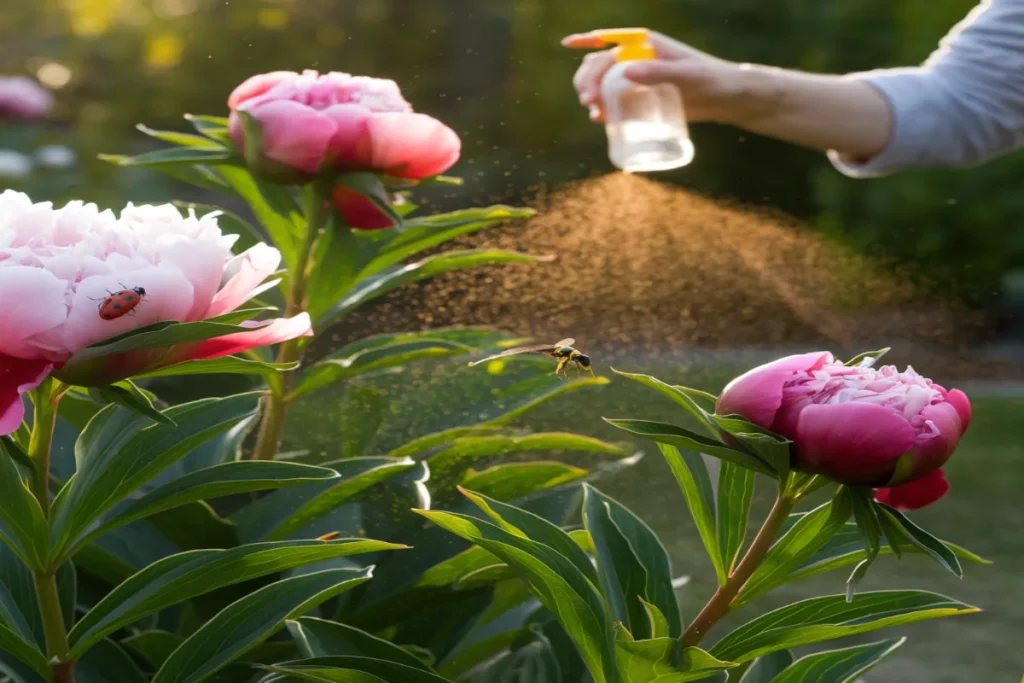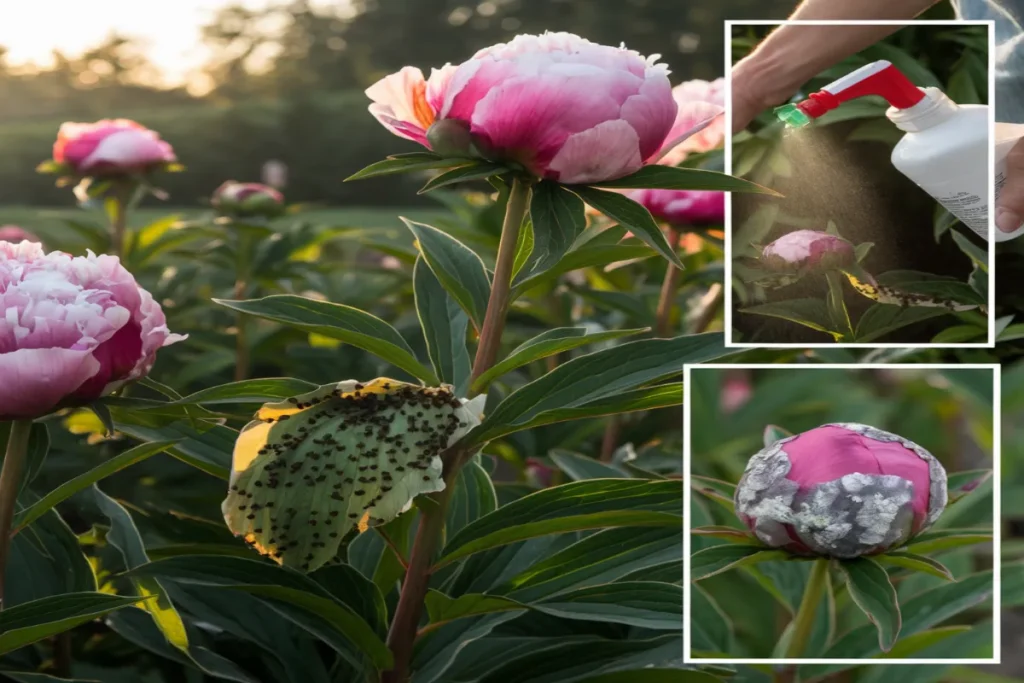Sarah Miller, a seasoned gardener in Portland, Oregon, found her prized peonies under attack one summer morning. What started as a routine check became a critical mission to save her beloved flowers.
Peonies are more than just beautiful flowers; they are delicate ecosystems needing careful attention. Gardeners who love these flowers know that keeping pests away is essential for their health and beauty.
The art of peony pest control involves understanding the balance between plant health, environment, and threats. These plants face many challenges, from tiny aphids to fungal diseases, that can harm their growth and blooms.
Successful gardeners believe in prevention over treatment. By using proactive strategies and staying alert, you can keep your peonies safe from pests and ensure their beauty and health.
This guide will show you important techniques, organic solutions, and expert tips to keep your peonies strong and healthy all season.
Table of Contents
Understanding Peony Pests
Peonies are loved by many gardeners. But, they face many pests. Knowing how to control these pests is important.
Gardeners must watch out for insects that harm peonies. This helps keep the plants healthy.
Common Insect Invaders
Several pests are a big threat to peonies:
- Aphids: Tiny insects that cluster on new growth and undersides of leaves
- Thrips: Microscopic pests causing silvery leaf damage
- Mealybugs: White, cotton-like insects that secrete sticky honeydew
- Scale insects: Armored pests that can cause leaf mottling and yellowing
Identifying Damage Symptoms
Spotting pest damage early is key. Look for these signs:
- Distorted or curled leaves
- Discoloration or unusual spotting
- Stunted growth
- Wilting despite adequate watering
*Nematodes can be challenging, surviving in debris for up to 3 years.*
Root nematodes can harm peonies a lot. They cause swelling and galls. This stops water and nutrients from reaching the plant.
The western flower thrip is also a big problem. It can spread serious viruses that harm peonies.
Watching your garden closely and acting fast is important. Even though peonies are mostly pest-resistant, knowing the risks helps protect them.
Importance of Early Detection
Protecting peonies from pests needs a proactive plan. Early detection is key to managing pests effectively. Gardeners who know how to protect peonies start with watching closely and acting fast.
Monitoring Your Garden Regularly
Watching your garden often helps keep peonies healthy. Experts say to check your garden every week. This helps catch pest problems early.
Good monitoring includes:
- Checking plant leaves for discoloration
- Examining stems for unusual webbing
- Looking for signs of insect activity
- Assessing overall plant health
Tools for Effective Pest Monitoring
Right tools are needed for pest detection. Gardeners should get some key monitoring tools:
| Monitoring Tool | Purpose | Effectiveness Rating |
|---|---|---|
| Magnifying Glass | Detailed Insect Inspection | 90% |
| Sticky Traps | Capturing Flying Insects | 85% |
| Pheromone Lures | Identifying Specific Pest Populations | 75% |
Early detection can cut pest damage by 50%. A regular monitoring plan helps keep peonies safe and your garden healthy.
“Prevention is always better than cure in garden pest management.” – Professional Gardening Expert
Stressed peony plants attract pests more easily. Keeping plants healthy is the best way to protect them from pests.
Natural Pest Control Methods

Gardeners looking to protect their peonies have many natural ways to do so. These methods not only fight pests but also keep the garden’s ecosystem balanced.
Beneficial Insects: Nature’s Pest Management Team
Adding beneficial insects to your peony garden can greatly reduce pests. Studies show these natural predators can cut down harmful insects by up to 90%.
- Ladybugs: Eliminate aphids with remarkable efficiency
- Lacewings: Consume soft-bodied garden pests
- Predatory wasps: Target caterpillars and harmful larvae
Organic Pesticides for Home Use
Organic pesticides are a safe choice for peony pest control. They effectively manage pests without harming plants.
| Organic Pesticide | Target Pests | Effectiveness |
|---|---|---|
| Neem Oil | Aphids, Mites | 85% Reduction |
| Insecticidal Soap | Soft-bodied Insects | 80% Control |
| Diatomaceous Earth | Crawling Insects | 75% Elimination |
Using these natural methods, gardeners can safeguard their peonies while being eco-friendly. Integrated pest management helps avoid chemicals and supports a healthy garden ecosystem.
“Nature provides the most elegant solutions to garden pest challenges.” – Sustainable Gardening Experts
Chemical Pest Control Options
When natural methods don’t work, chemical pest control is a good choice for peonies. It’s important to pick the right treatment for each pest problem.
Recommended Commercial Insecticides
Professional gardeners use chemicals to tackle tough pest issues. They choose products that target specific pests for the best results.
| Pest Type | Recommended Product | Application Rate | Reentry Time |
|---|---|---|---|
| Fungus Gnats | Soil Drench Insecticide | 10-17 fl oz/100 gal water | 12 hours |
| Spider Mites | Mural Fungicide | 4-7 oz/100 gal water | 12 hours |
| Aphids | CuPRO 5000 | 1.5-2 lb/Acre | 48 hours |
Safety Precautions When Using Chemicals
Using chemicals for pest control needs careful safety steps. Gardeners must wear protective gear and apply chemicals correctly.
- Wear protective gloves and eyewear
- Follow manufacturer’s recommended dosage
- Avoid application during windy conditions
- Store chemicals in locked, cool areas
- Keep children and pets away during treatment
*Integrated Pest Management (IPM) recommends combining chemical treatments with natural approaches for complete pest control.*
Choosing the right chemical pest control for peonies means knowing how each product works. It’s also key to rotate different chemicals to avoid pest resistance and protect the environment.
Seasonal Pest Management Strategies
Effective peony pest control needs a plan that changes with the seasons. Knowing the challenges each season brings helps gardeners keep their peonies safe.
Spring: Preemptive Pest Management Actions
Spring is a key time for peony pest control. As plants wake up from winter, gardeners must act fast to stop pests:
- Inspect plants for early signs of pest activity
- Remove winter debris that might harbor overwintering insects
- Apply preventative treatments during the button stage of peony growth
Thrips can be a big problem in spring. Studies show these pests can have many generations in one growing season. They fly most in mid to late June.
Summer: Ongoing Pest Monitoring Techniques
Summer means keeping a close eye on peonies. Gardeners should use strong pest control plans:
- Conduct weekly plant inspections
- Use blue sticky cards to track thrips activity
- Rotate insecticides to prevent resistance
*Monitoring is key to early pest detection and successful management.*
Using acephate, azadirachtin, and spinosad can help with thrips. Peonies do best in USDA zones 3 to 8. Keeping up with pest control is vital for their health and beauty.
Specific Pests and Their Control

Peony gardeners face many challenges to protect their plants from pests. It’s important to know these threats to keep peonies healthy and vibrant. The best pest control for peonies depends on identifying pests and using the right strategies.
Aphids: Prevention and Treatment
Aphids are a big problem for peonies. These tiny insects can harm plants in several ways:
- They produce honeydew, a sticky substance that attracts sooty mold
- They cover leaves, blocking sunlight needed for photosynthesis
- They can spread plant viruses
To control aphids on peonies, several methods are effective:
- Bring in beneficial insects like ladybugs
- Apply insecticidal soap or neem oil
- Use strong water sprays to wash off aphids
Fungal Diseases: Identification and Action
Fungal diseases like Botrytis blight and powdery mildew can destroy peonies. It’s vital to act quickly to stop these diseases.
*Early detection is the key to successful pest management in peonies.*
Studies show that using a mix of pest management strategies can help a lot. Keeping the soil healthy, ensuring good air flow, and checking plants regularly are key to caring for peonies.
For the best pest control for peonies, focus on prevention, early detection, and specific treatments for each pest.
Creating a Pest Control Schedule
Creating a pest control schedule is key for healthy peonies. It’s important to plan and monitor regularly. This helps keep these beautiful plants safe from pests.
Managing your garden well means being proactive about pests. Make a detailed schedule for peony care. It should tackle the challenges each season brings.
Timing for Applications
When you apply pest control matters a lot. Here are some important times to do so:
- Early spring: Check for pests that stayed through winter
- Late spring: Watch for new insects
- Summer: Inspect weekly
- Fall: Get plants ready for winter
Seasonal Checklist for Peony Care
Peony care needs focus all growing season. Here’s a monthly plan:
- March-April: Clean up winter mess, look for pests
- May-June: Start treatments to prevent pests
- July-August: Deal with pests that are active
- September-October: Get plants ready for sleep
*”Prevention is always more effective than treatment in garden pest management.”*
Regular checks are vital. Experts say to inspect weekly during growing season. Good soil and sunlight help fight pests too.
With a good pest control plan, you can keep your peonies healthy. This way, they can grow strong and beautiful.
Frequently Asked Questions
How do I get rid of bugs on my peonies?
The best ways to remove bugs from peonies include:
Spraying them off with water – A strong blast from a hose can knock off aphids and other small pests.
Neem oil or insecticidal soap – Works well for aphids, mites, and thrips.
Hand-picking larger bugs – Japanese beetles and caterpillars can be removed manually.
What do you spray peonies with?
Insecticidal soap – Safe for plants and good for soft-bodied pests like aphids.
Neem oil – A natural pesticide that controls mites, thrips, and fungal diseases.
Homemade soap spray – Mix a few drops of dish soap with water and spray on leaves.
Bt (Bacillus thuringiensis) – A natural treatment for caterpillars.
What is eating my peonies?
If your peonies have chewed-up leaves or damaged buds, it could be:
Japanese beetles – They love munching on foliage.
Thrips – These tiny pests damage buds and flowers.
Caterpillars – Some larvae chew on leaves.
Deer or rabbits – Rare, but they sometimes nibble on peony shoots.
What is the downside of peonies?
Peonies are gorgeous, but they do have a few quirks:
Short bloom time – They only flower for a few weeks in late spring/early summer.
Heavy blooms need support – Large flowers can flop over without staking.
They don’t like being moved – Peonies prefer to stay in the same spot for years.
Ants love them – While harmless, ants crawling on the buds can be annoying.
What is a natural ant repellent for peonies?
If you want to keep ants off your peonies without harming them, try:
Sprinkling cinnamon or diatomaceous earth around the base of the plant.
Wiping the buds gently with a damp cloth before bringing them inside.
Using a soapy water spray – Mix a few drops of dish soap with water and mist the buds.
What can I spray on my flowers to keep bugs from eating them?
For general bug prevention, you can use:
Neem oil – A safe, natural option for most garden pests.
Insecticidal soap – Works well on soft-bodied insects like aphids.
Garlic or chili pepper spray – Mix crushed garlic or hot pepper with water to deter bugs.
Diatomaceous earth – Sprinkle it around the base of the plants to keep crawling insects away.

